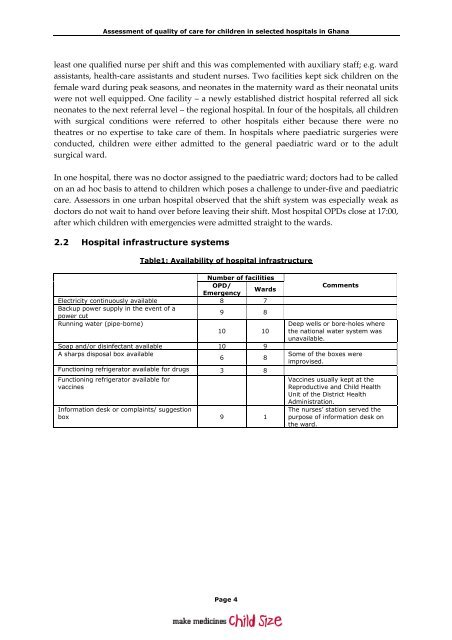Assessment of quality of care for children in selected hospitals in ...
Assessment of quality of care for children in selected hospitals in ...
Assessment of quality of care for children in selected hospitals in ...
Create successful ePaper yourself
Turn your PDF publications into a flip-book with our unique Google optimized e-Paper software.
<strong>Assessment</strong> <strong>of</strong> <strong>quality</strong> <strong>of</strong> <strong>care</strong> <strong>for</strong> <strong>children</strong> <strong>in</strong> <strong>selected</strong> <strong>hospitals</strong> <strong>in</strong> Ghanaleast one qualified nurse per shift and this was complemented with auxiliary staff; e.g. wardassistants, health‐<strong>care</strong> assistants and student nurses. Two facilities kept sick <strong>children</strong> on thefemale ward dur<strong>in</strong>g peak seasons, and neonates <strong>in</strong> the maternity ward as their neonatal unitswere not well equipped. One facility – a newly established district hospital referred all sickneonates to the next referral level – the regional hospital. In four <strong>of</strong> the <strong>hospitals</strong>, all <strong>children</strong>with surgical conditions were referred to other <strong>hospitals</strong> either because there were notheatres or no expertise to take <strong>care</strong> <strong>of</strong> them. In <strong>hospitals</strong> where paediatric surgeries wereconducted, <strong>children</strong> were either admitted to the general paediatric ward or to the adultsurgical ward.In one hospital, there was no doctor assigned to the paediatric ward; doctors had to be calledon an ad hoc basis to attend to <strong>children</strong> which poses a challenge to under‐five and paediatric<strong>care</strong>. Assessors <strong>in</strong> one urban hospital observed that the shift system was especially weak asdoctors do not wait to hand over be<strong>for</strong>e leav<strong>in</strong>g their shift. Most hospital OPDs close at 17:00,after which <strong>children</strong> with emergencies were admitted straight to the wards.2.2 Hospital <strong>in</strong>frastructure systemsTable1: Availability <strong>of</strong> hospital <strong>in</strong>frastructureNumber <strong>of</strong> facilitiesOPD/EmergencyWardsElectricity cont<strong>in</strong>uously available 8 7Backup power supply <strong>in</strong> the event <strong>of</strong> apower cut9 8Runn<strong>in</strong>g water (pipe-borne)10 10Soap and/or dis<strong>in</strong>fectant available 10 9A sharps disposal box available6 8Function<strong>in</strong>g refrigerator available <strong>for</strong> drugs 3 8Function<strong>in</strong>g refrigerator available <strong>for</strong>vacc<strong>in</strong>esIn<strong>for</strong>mation desk or compla<strong>in</strong>ts/ suggestionbox 9 1CommentsDeep wells or bore-holes wherethe national water system wasunavailable.Some <strong>of</strong> the boxes wereimprovised.Vacc<strong>in</strong>es usually kept at theReproductive and Child HealthUnit <strong>of</strong> the District HealthAdm<strong>in</strong>istration.The nurses’ station served thepurpose <strong>of</strong> <strong>in</strong><strong>for</strong>mation desk onthe ward.Page 4
















